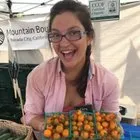A Farmer's Guide to Hosting Classes: Part II
Photo credit to Cynthia Sandberg at Love
Apple Farms
In our last post,
we explored the first steps in planning a class, from defining your target audience and
setting objectives to thinking logistically about space and resources. If you’ve got a
plan and are ready to move forward, here are some ideas for marketing your class,
getting other folks involved -- and planning ahead for the next one.
Get the word out! Handing out flyers at farmers market and sharing the event via
social media are both great ways to tell people about your class or workshop. Does the
co-op you do business with have a message board or newsletter? Can you post flyers at
your nearby library, college, yoga studio, community garden, or advertise in the local
paper? Do any of your restaurant accounts send emails to interested customers that
include farm happenings? To get the word out initially, consider offering a perk (ie: $5
to spend at your farm stand or market for anyone who signs up by a certain date) or gift
certificates.
Encourage online registration via your website and in your next CSA newsletter. This
will give you an idea of how many attendees to expect, so you can plan ahead for enough
materials. It will help you keep a running contact list of past attendees when advertising
future classes. And it will allow you to cap the total number of participants, if necessary,
keeping the class to a manageable size.
Loop in your farm staff. Determine to what extent various staff members will be
involved with the class, and check in with everyone about their individual roles and
responsibilities. You’ll want your team to feel prepared and confident in how to handle
certain situations (ie: at attendee acting inappropriately, breaking one of the rules,
etc.)
Prepare your materials. Order any supplies you might not have on-hand, or materials you’ll
cover in the class that folks may want to purchase from you and take home with them -- for example,
tomato cages or clips for a class on trellising. Plan to lay everything out so multiple participants
can access them easily, and keep the flow of the class running smoothly. For example, you might want
to pre-harvest flowers for a class on bouquet-making, especially if your target audience may not
have experience harvesting flowers, or if the flower field is far away from the shaded area where
you’ll be making bouquets. (Also, it is generally a good idea to avoid giving people sharp objects
unless absolutely necessary… and you have good insurance.)

Photo credit to Cynthia Sandberg at Love
Apple Farms
Before the class:
-
Do a run-through of the class day with your staff or any volunteer helpers.
-
Be a good neighbor and check in with yours if you anticipate additional traffic.
-
Make sure your signage is ready, parking is clearly designated, bathrooms are in place, etc.
-
Tidy up. Don’t underestimate the power of a beautiful space to impress your visitors… and bring them back again.
On class day:
-
Be a good host. Greet folks, make them feel welcome, thank them for attending.
-
Have folks sign in. Ask for their emails (if you haven’t already gotten them via online registration) and get the go-ahead to take photos! You’ll want both later.
-
Communicate clearly any farm rules (ie: no walking in beds, picking anything, touching the tractor).
-
Briefly explain how the class will run, so participants knows what to expect.
-
Send participants home with something: a hand-out, a recipe, a packet of seeds.
Remember that first class is likely going to be the most challenging. Probably a
mistake will be made, or something won’t go the way you expect it to. As a farmer, you
already know how to be adaptable and roll with the punches. Just remember that while
little things may go wrong (the soil is too wet, the garlic is the wrong variety, the
rubber bands went missing and now we have to use twine instead!), you’re the only one
that knows it -- your participants probably won’t even notice.
Afterwards, follow up! This is a chance to thank participants for attending, request
feedback, and to plug upcoming classes. Include a thank-you note in your next newsletter and via
social media. (Remember also to thank your staff and volunteers!) Send out a survey to get feedback
and ascertain which of your participants want to be contacted regarding upcoming classes.
Look back on your goals and objectives, and assess what went well and what could use improvement.
Together with some helpful feedback, a solid email list, and those great photos you took, you’re
this much closer to hosting and promoting another successful class on your farm!
If you liked this article, and want to see more like it, enter your email in the subscribe box to the top-right of this page and we'll send you new blog articles as we publish them.

After graduating from UCSC's
Center for Agroecology and Sustainable Food Systems, Lauren Alexandra Kaplan spent a season at
an organic CSA farm in California before returning east to farm in the Hudson Valley. Prior to
pursuing farming full time, she worked in book publishing and helped to launch an urban farm in
NYC. Alexandra is an avid salsa dancer and maker of jams, pickles, and kraut.